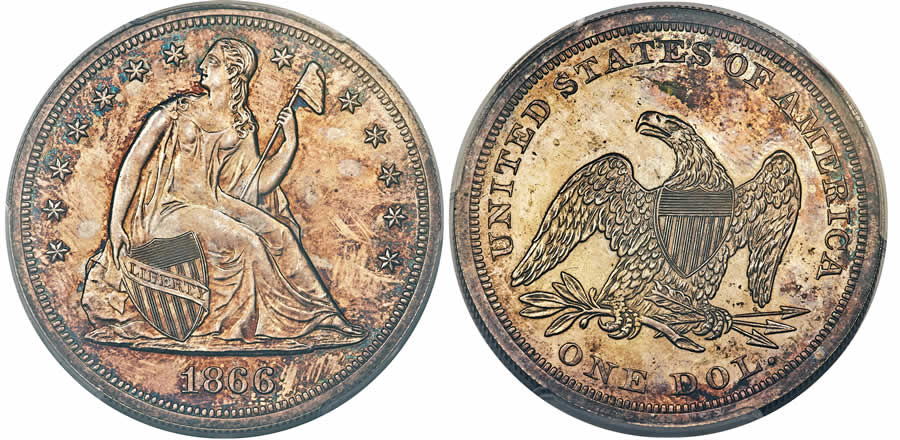1866 NO MOTTO SEATED LIBERTY DOLLAR A SOUGHT-AFTER PRIZE FOR ADVANCED COLLECTORS OF PATTERNS AND SEATED LIBERTY DOLLARS ALIKE
By David Stone
With only two examples known to collectors today, the 1866 No Motto Seated Liberty dollar is so rare that most collectors tend to overlook the issue.
RARE COINS
EVENT
U.S. COINS SIGNATURE® AUCTION 1329
Featuring Important Selections from the Bob R. Simpson Collection, Part V
April 22-26, 2021
Online: HA.com/1329a
INQUIRIES
800-USCOINS (872-6467)
When discussing the rarest and most valuable U.S. coins, the conversation usually focuses on more famous issues, like the 1804 dollar (15 examples known), the 1913 Liberty nickel (five specimens extant) or the 1894-S Barber dime (nine survivors known). The much more elusive 1866 No Motto dollar is seldom mentioned, as its public offerings occur so infrequently that the coin remains out-of-sight and out-of-mind for most collectors. Its availability is further diminished because one of the two known specimens is impounded in the National Numismatic Collection at the Smithsonian Institution, where no collector will ever acquire it.
Against this backdrop of relative anonymity, Heritage Auctions is offering the only available example of this overlooked rarity in its April 2021 catalog of Important Selections from the Bob R. Simpson Collection, Part V. Hopefully, this high-visibility appearance will increase collector interest in the 1866 No Motto dollar, one of the rarest issues in American coinage.
‘TRANSITIONAL’ PATTERNS
The motto IN GOD WE TRUST was added to the design of the regular-issue Seated Liberty dollar, half dollar and quarter in 1866. At some point, early pattern specialist Robert Coulton Davis obtained a set of the three silver denominations dated 1866 that were struck without the motto. The coins were reportedly “transitional” patterns, struck before the design change took place, but most numismatists agree they were actually fantasy pieces, struck specifically for sale to Davis.
Interestingly, Dick Osburn and Brian Cushing have identified the obverse die as the same one used to strike some proof With Motto Seated Liberty dollars in 1866 (the OC-P2 variety). Similarly, they identify the reverse die as the same one used to strike some extremely rare proof 1865 Seated Liberty dollars (the OC-P1 variety). The dies appear to be in the same state during all these uses. Since both obverse and reverse dies were on hand in the Mint in 1866, it is possible that the 1866 No Motto dollars were actually struck that year, but most numismatists believe they were struck later, in the 1869-1870 time frame.
Chief Coiner Archibald Loudon Snowden was probably the man who struck the 1866 No Motto coins for Davis. He seems to have liked the idea so much that he struck a second example of the dollar for himself. Snowden acquired a massive collection of patterns and other rarities during his service at the Mint, which lasted for decades. He was able to purchase the coins by exchanging an equivalent value in coins or bullion for them, a practice that remained legal for Mint employees until the 1930s.
R.C. Davis retained his set of No Motto coins for many years, but the set was split up after his death in 1888. The coins followed different paths until Willis duPont succeeded in rejoining them all in 1961. The set was stolen, along with the rest of duPont’s collection, in a daring armed robbery in 1967. All three coins were eventually recovered and returned to duPont, with the dollar being the last to surface in 2004. Afterward, the set was exhibited at the ANA Money Museum for an extended period before being donated to the National Numismatic Collection in 2014.
Enlarge

Snowden’s dollar has an equally interesting history. Snowden held on to his hoard of rarities until long after he retired, but he began selling off some of his coins in the early 20th century. His most notable transaction involved the two 1877 fifty-dollar Half Union patterns in gold, which he sold to prominent collector William H. Woodin for the unheard-of price of $20,000, through John W. Haseltine and Stephen Nagy. The public became aware of this transaction, due to some articles Edgar Adams published in The Numismatist, and a strong feeling developed that the coins should never have been released from government holdings. After much legal maneuvering, Woodin agreed to return the Half Unions to the Mint, Snowden kept the money, but surrendered his hoard of numismatic treasures to Woodin in exchange. In this manner, Woodin acquired examples of more than half the patterns listed in the Adams-Woodin pattern reference that was published in 1913, several 1884 Trade dollars, all five 1885 Trade dollars and many other rarities, including Snowden’s 1866 No Motto dollar.
FAMOUS COLLECTIONS
Like many collectors over the years, William Woodin seems to have underrated the 1866 No Motto dollar, as he soon sold it to H.O. Granberg, along with the No Motto quarter and half dollar he had acquired earlier. The new set was exhibited at the 1914 ANS Exhibition and later passed through the famous collections of F.C.C. Boyd, “Colonel” Green and King Farouk, before being split up again (the quarter and half dollar were eventually acquired by duPont, to reconstitute the set). The Snowden dollar then appeared in a string of Stack’s auctions in the 1960s, and was finally featured in lot 31 of the Kennywood Collection (American Numismatic Rarities, 1/2005), which realized a substantial $1,207,500. The coin has been in Bob Simpson’s remarkable collection ever since.
Designated Judd-540 in the leading pattern reference, the 1866 No Motto Seated Liberty dollar is a sought-after prize for advanced collectors of patterns and Seated Liberty dollars alike.
 DAVID STONE is a numismatic cataloger at Heritage Auctions who has written for The Numismatist and Coin World.
DAVID STONE is a numismatic cataloger at Heritage Auctions who has written for The Numismatist and Coin World.
This article appears in the Spring 2021 edition of The Intelligent Collector magazine.


